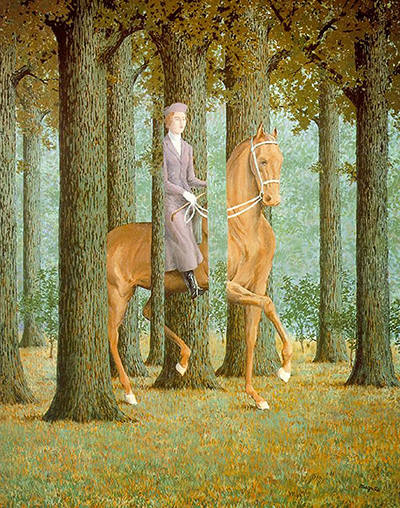One of the paintings completed near the end of Magritte's life was The Blank Signature in 1965.
The painting also goes by the name Le Blanc Seing and La Carte Blanche. Magritte's paintings are often illogical and play with the viewer's mind. What stands out about The Blank Signature is that it literally is illogical and inconsistent because it is an optical illusion.
While Magritte's intention with art was to puzzle the mind, he actually created a puzzle with this painting. At first glance, this is an image of a woman riding a horse through a forest.
However, the mind quickly realizes this image is impossible as the trees, the rider and the horse are intertwined in a strange way. The horse and the rider are both in front of and behind the trees.
Parts of them are even hidden by the leaves in the background. The more the painting is analyzed, the more it is mysterious and confusing. It is also baffling how Magritte was able to create such a perplexing image.
Magritte's technique in this painting is comparable to the image of the impossible trident which has three prongs at one end and changes into only two at the opposing end. Both similarly confuse the mind.
The Blank Signature is also considered to be an occlusion illusion. Occlusion refers to the order of objects as it gives the eye the perception of an object being in front of or behind another object.
The reason why Magritte's painting is an occlusion illusion is because occlusion is not actually present in the painting. The order or layering of the objects is mixed up and occlusion is actually non-existent.
It is also notable how the image of the horse and the rider are quite realistic in and of themselves. The forest and the colors used are likewise realistic.
The meaning of this painting is therefore not in the actual subject but rather in the confusing presentation of the subject. The Blank Signature is an excellent example of the genius artistic mind of Magritte and proof of his capacity to confuse viewers and bewilder the mind.
Interest in Magritte's body of work increased in the 1960s. He was fortunate to received recognition and praise for his work during his lifetime. This includes The Blank Signature.
The American band Styx used an altered version of this painting for the cover of their 1977 album The Grand Illusion. The painting is also continuously discussed for its perplexity and significance to how the mind works when viewing images. The painting has also been part of numerous exhibitions around the world throughout the years since Magritte completed it.
Today, The Blank Signature is part of the Collection of Mr. and Mrs. Paul Mellon but is currently held at the National Gallery of Art in Washington, D.C.
Belgian artist Rene Magritte made a name for himself by creating surrealist paintings that made viewers ask questions about reality and ponder the mind of the painter.
Born in Belgium in 1898, Magritte began to study and learn art as early as 1910. His early paintings were inspired by various artistic styles, including Futurism, Cubism and Impressionism. After his first exhibition was poorly received by critics in Brussels, Magritte moved to Paris in 1927.
It is here that Magritte became part of the surrealist group and a leader of the artistic movement. Magritte also met and befriended Andre Breton, the founder of Surrealism.
Surrealism is characterized by absurd, inconsistent and contradictory images that blend reality and dreams while also exposing the artist's unconscious and philosophical ideas.
During World War II, Magritte lived in German-occupied Belgium and his paintings began to reflect his feelings of alienation caused by the war.
He would return to his more optical and mysterious paintings afterwards. Magritte lived in Brussels for the rest of his life before succumbing to pancreatic cancer in 1967. He continued to create intriguing and original paintings until his death.




